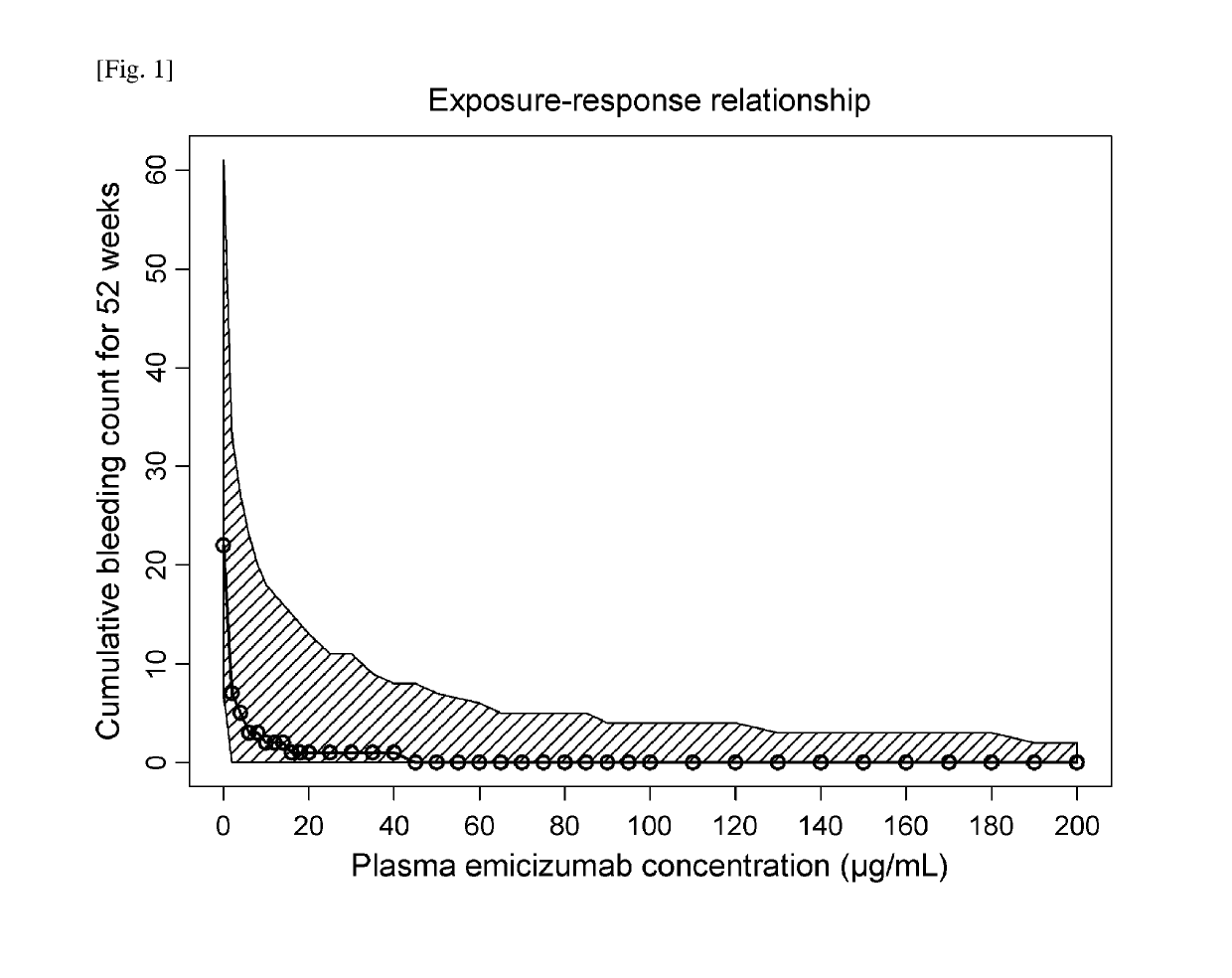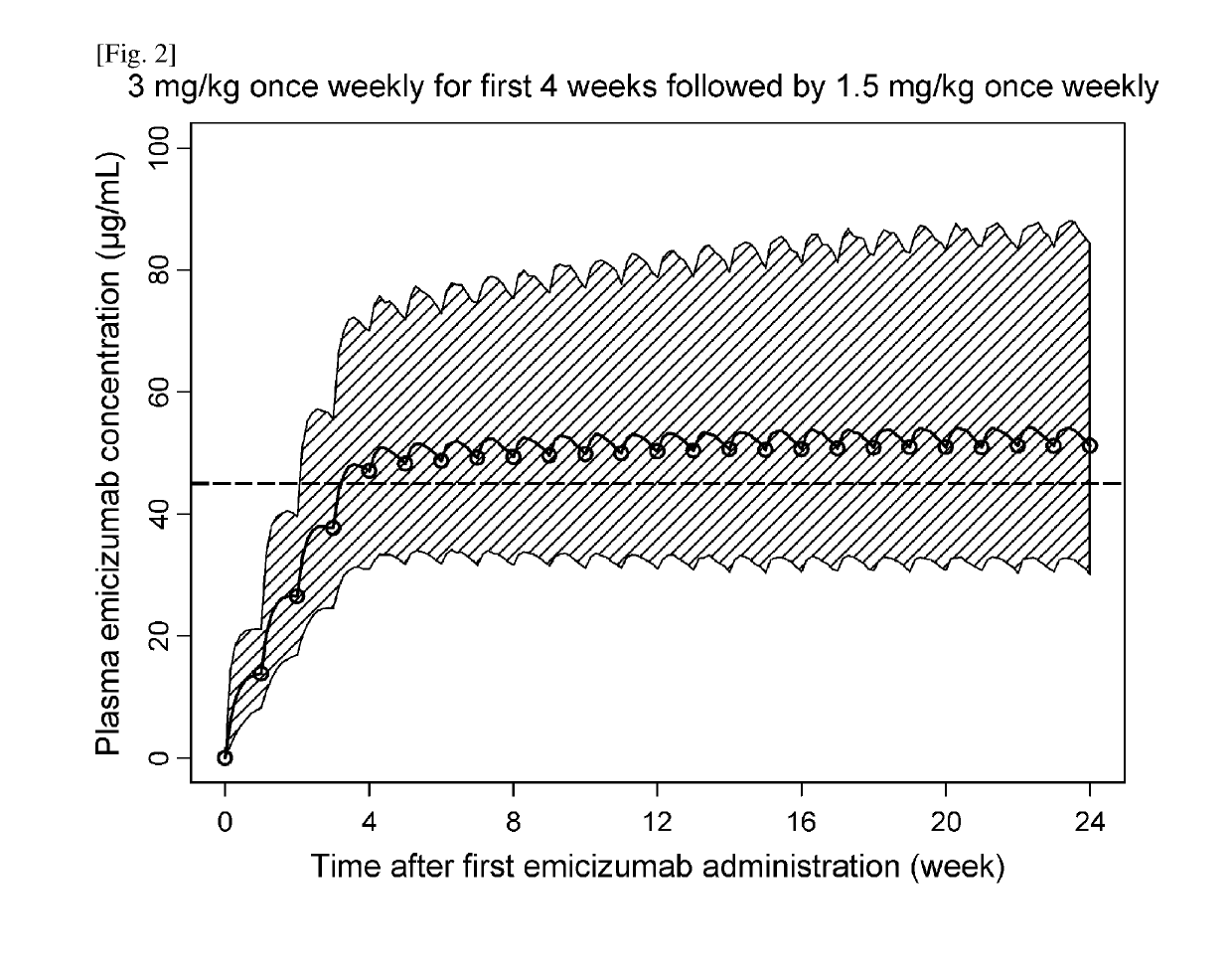Methods of using a bispecific antibody that recognizes coagulation factor ix and/or activated coagulation factor ix and coagulation factor x and/or activated coagulation factor x
a technology of activated coagulation factor and coagulation factor x, which is applied in the field of therapeutics for bleeding disorders, can solve the problems of insufficient suppression of bleeding, difficulty in securing a blood vessel, and insufficient effect of bypassing agents, so as to reduce the incidence of bleeding
- Summary
- Abstract
- Description
- Claims
- Application Information
AI Technical Summary
Benefits of technology
Problems solved by technology
Method used
Image
Examples
example 1
[0313]Efficacious Dosing Regimens with Administration Interval Extension and / or Dose Up-Titration
[0314]Dose-Exposure-Response Model Development
[0315]A population pharmacokinetic (PopPK) model of emicizumab was developed using the quantifiable plasma emicizumab concentration data from 42 healthy subjects (NPL 8) and 18 patients with hemophilia A having or not having FVIII inhibitors (NPLs 9 and 10). In addition, the exposure-response relationship on the bleeding-prophylactic efficacy of emicizumab was quantitatively characterized based on a repeated time-to-event (RTTE) modeling approach using the bleeding onset data from the same 18 patients (NPLs 9 and 10).
[0316]A one-compartment model with first-order absorption and first-order elimination was employed as the structural PopPK model to describe the plasma emicizumab concentration-time profile. The parameter estimates of the PopPK model including covariate effects are listed in Table 1.
TABLE 1Parameter Estimates of the Population Ph...
example 2
[0324]A Randomized, Multi-Center, Open-Label Phase III Clinical Trial to Evaluate the Efficacy, Safety and Pharmacokinetics of Prophylactic Emicizumab Versus No Prophylaxis in Hemophilia A Patients with Inhibitors (HAVEN 1)
[0325]This multicenter, open-label study evaluated the safety, efficacy and pharmacokinetics of prophylactic emicizumab treatment or regular emicizumab administration therapy in patients previously treated with episodic or prophylactic bypassing agents. Episodic bypassing agent patients were randomized in a 2:1 fashion to receive emicizumab prophylaxis (Arm A) versus no prophylaxis (Arm B) and were stratified across Arms A and B according to the number of bleeds they had experienced over the last 24 weeks prior to study entry (less than [=] 9 bleeds); Arm B patients had the opportunity to switch to emicizumab prophylaxis after 24 weeks on-study. Prophylactic bypassing agent patients switched to emicizumab prophylaxis (Arm C) from the start of the trial; enrollment...
example 3
[0344]Efficacy, Safety and Pharmacokinetics (PK) of Once-Weekly Prophylactic (Px) Emicizumab (ACE910) in Pediatric (<12 Years) Persons with Hemophilia A with Inhibitors (PwHAwI): Interim Analysis of Single-Arm, Multicenter, Open-Label, Phase 3 Study (HAVEN 2)
[0345]The study enrolled PwHAwI aged <12 years (or 12-17 years if <40 kg) previously treated with bypassing agents (BPAs) to receive emicizumab prophylaxis for 52 or more weeks. Efficacy objectives included annualized bleeding rate (ABR) and bleed reduction versus historical bleed rate (non-interventional study).
[0346]Participants received weekly subcutaneous (SC) administrations of emicizumab for a designated period of 52 weeks. All participants continued to receive standard of care / background treatment with their usual episodic bypassing agent therapy to treat breakthrough bleeds as needed.
[0347]Emicizumab was administered SC once weekly for 52 weeks, 3 milligrams per kilogram per week (mg / kg / week) for 4 weeks and 1.5 mg / kg / we...
PUM
| Property | Measurement | Unit |
|---|---|---|
| frequency | aaaaa | aaaaa |
| frequency | aaaaa | aaaaa |
| frequency | aaaaa | aaaaa |
Abstract
Description
Claims
Application Information
 Login to View More
Login to View More - R&D
- Intellectual Property
- Life Sciences
- Materials
- Tech Scout
- Unparalleled Data Quality
- Higher Quality Content
- 60% Fewer Hallucinations
Browse by: Latest US Patents, China's latest patents, Technical Efficacy Thesaurus, Application Domain, Technology Topic, Popular Technical Reports.
© 2025 PatSnap. All rights reserved.Legal|Privacy policy|Modern Slavery Act Transparency Statement|Sitemap|About US| Contact US: help@patsnap.com



